Sony DSC-M1: Good Video, Disappointing Pictures
by Stephen Caston on June 20, 2005 12:05 AM EST- Posted in
- Digital Camera
The Design: Sony DSC-M1
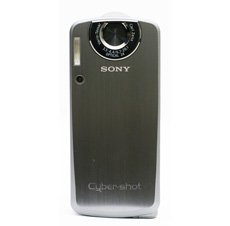 |
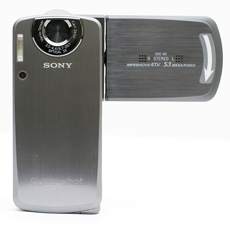 |
| Click images to enlarge. | |
The front of the M1 features a 3x Carl Zeiss lens capable of a 38-114mm optical zoom (35mm equivalent). The built-in flash can be found just to the left of the lens. Because of its small size, the output is significantly less than average (1.0 - 5.9' at wide angle). The AF-assist/self-timer lamp is located just below the built-in flash. From this angle, we can also see two microphones on the back of the LCD panel, which give the M1 the ability to record stereo audio.
On the back of the M1 is the 2.5" LCD monitor, which contains 123K pixels and can rotate a full 270º. On the left side of the LCD are three buttons. The Photo and Movie buttons can be used as an alternative to the Photo/Movie buttons in the main control area. They also act as back/forward buttons when viewing images and movies. The middle button serves to start/pause video during playback. To the right of the LCD monitor is the speaker that plays back audio from recorded movie clips. Directly above the speaker is the slot for the Memory Stick Duo flash card. Just to the right of the word "Pro" is a tiny access lamp, which illuminates while the camera is writing data to the card. Starting at the upper right, we can see the Reset button and three indicator lamps. Each lamp will illuminate according to the current status of the camera: charging, Record mode, or Playback mode. The Mode button allows you to select the camera's mode from Record or Playback. Below the rotating LCD monitor are the main controls for the camera. Sony's dedication to video is apparent on the M1 through the inclusion of both a photo and movie shutter button. This means that you don't have to switch to video mode in order to shoot a video. Instead, you simply press the Movie shutter button to begin recording. Below both the Photo and Video buttons are switches that can alter their functionality. In between the shutter buttons is the zoom controller that operates the optical zoom in Record mode as well as the magnification of images during Playback. Surrounding the 4-way controller are the Menu, Image size/Delete, and Display buttons. The 4-way controller has a separate "set" button in the middle. At this point, we feel we should mention that the smaller buttons on the back of the M1 are recessed just enough to make them hard to press at times. Primarily, we are talking about the Menu, Image Size/Delete, Display, and Set buttons.
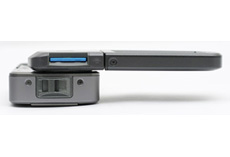 |
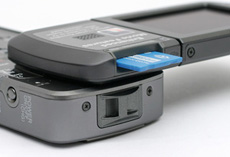 |
| Click images to enlarge. | |
With the LCD monitor flipped open, we can see the Memory Stick Duo Pro media slot, which accepts regular Duo as well as Pro Duo cards. The M1 comes with a 32 MB Duo card, but we recommend upgrading to something larger, since the 32 MB card will only hold a handful of 5 megapixel images or short video clips. From this angle, we can also see the post for the included wrist strap.
The bottom of the camera features a metal tripod mount as well as a rather flimsy plastic sliding door that conceals the battery compartment.
The Sony M1 uses the included NP-FT1 rechargeable Lithium-Ion battery (3.6V 680mAh).
On the right side of the camera is the main power button. However, the camera can also be turned on by simply rotating the LCD monitor to its open position. From this angle, we can also see the labels next to the lamps, which indicate the current camera mode.
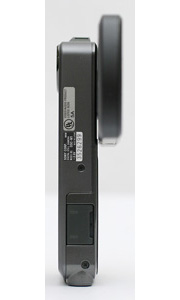 |
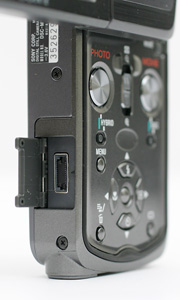 |
| Click images to enlarge. | |
On the left side of the camera is a plastic hinged cover that protects the multi-connector. The multi-connector is used to connect the camera to the charging dock. You may have noticed that there are no USB or TV-out ports on the camera. These ports are both located on the charging dock. Therefore, you must have the camera "docked" in order to use either the TV-out or USB functionality.
The Sony DSC-M1 is certainly an interesting camera because of its unusual design. We are glad to see that the body is made of metal, which gives it a rugged feel in our hands. Handling the camera takes some getting used to as it is very easy to block either the lens or AF-assist lamp if you aren't careful with your fingers. With the physical design out of the way, let's take a look at some of the recording capabilities of the M1.



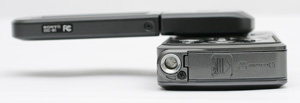
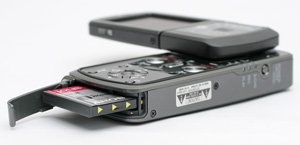









21 Comments
View All Comments
Nancymbsmo - Tuesday, January 17, 2012 - link
So far, Sony Cybershot has ruled in the camera market, but now as per the advent of new technologies and rising challenges, many people have shifted from Cybershot to other coolest digital cameras. But <a href="http://www.techiecop.com/cameras/sony-cameras/sony... Cybershot </a> DSC-M1 got Unique style and beautiful design along with powerful performance.